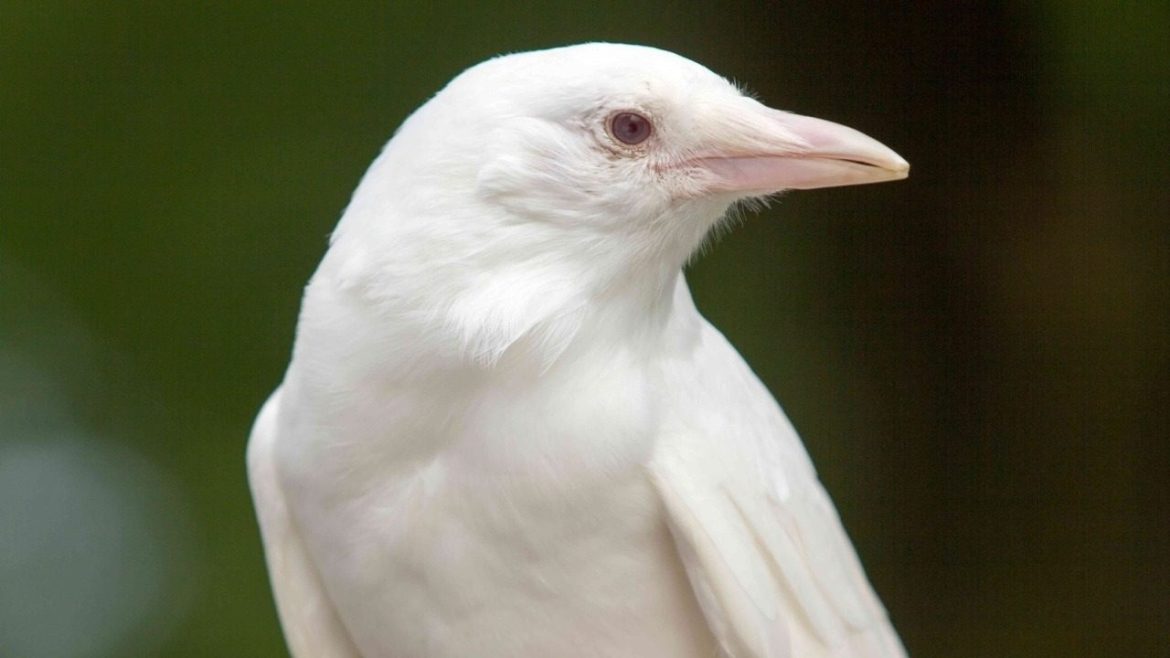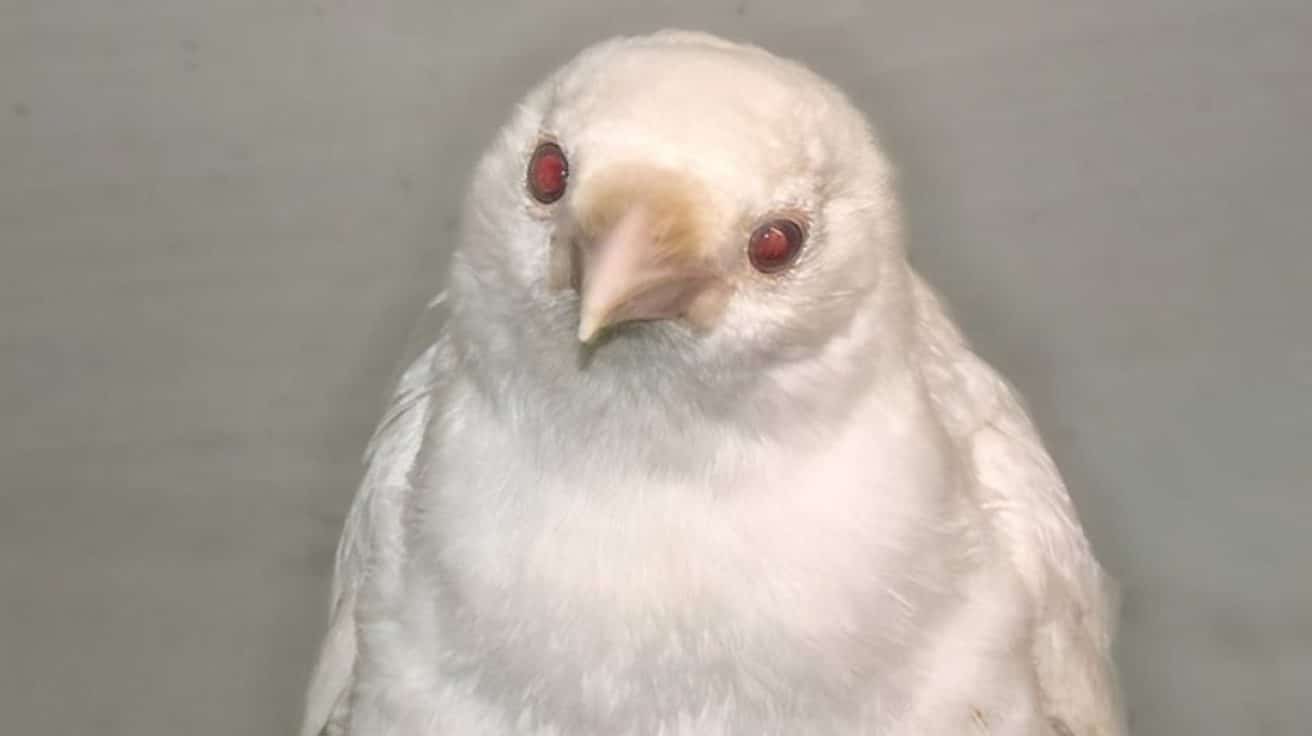Have you ever spotted a completely white crow among a group of black ones? These rare birds stop people in their tracks and cause a double-take.
While most of us know crows for their glossy black feathers and clever antics, a tiny fraction are born with a twist – they’re entirely white from beak to tail feathers!
These aren’t typical crows that have gone gray with age or dusty from a roll in chalk. They’re born with albinism due to an interesting genetic quirk.
White crows face a tough life in the wild, standing out when they’d rather blend in. Let’s examine these unusual birds, why they exist, how they survive, and what makes them special in the crow family.
Their story shows us just how varied and surprising nature can be.
What is an Albino Crow?
Albino crows lack the usual dark color due to a birth condition that stops their body from making melanin. Melanin gives birds their normal coloration, and without it, these crows show no pigment in their feathers, skin, or eyes.
You can identify a truly albino crow by its pink or red eyes – this happens because with no color in the iris, you can see the tiny blood vessels inside. This same condition appears in many other animals too.
It’s worth noting that albino crows differ from partly-white ones. Some crows may have white spots or areas but keep their normal dark eyes. Scientists call this different condition “leucism.”
Knowing the difference helps bird watchers categorize them correctly when documenting their observations.
What are the Causes of Albinism in Crows
Albinism in crows comes from inherited genes passed down from parents to their young. For a crow to be born albino, it must receive a specific gene form from both its mother and father.
This gene blocks the production of tyrosinase, an enzyme essential for making melanin pigment.
Genetic Inheritance
- Albinism follows a recessive inheritance pattern
- Both parents may appear normal with black feathers but still carry the hidden gene
- If two such crows mate, about one in four of their young could be albino
Environmental Factors
Some studies suggest that external factors might increase the frequency of albinism in certain areas:
- Man-made chemicals: Exposure to pollutants may affect genetic mutations
- Radiation levels: High exposure could alter genes over time
- Industrial zones: Birds near factories or waste sites sometimes show unusual color variations
Developmental Factors
- Disruptions during specific stages of embryo development can affect pigment cell migration
- Stress factors during egg incubation might influence gene expression
- Temperature variations during critical development periods may impact melanin production
However, clear scientific proof linking these factors to albinism remains limited. Researchers continue to study whether environmental influences truly play a role in shaping genetic traits in wild crow populations.
Where to Find Albino Crows?
Albino crows can appear anywhere crows live, including North America, Europe, and Asia, but they are extremely rare. Experts estimate fewer than 1 in 10,000 crows are truly albino.
Certain regions, such as the Pacific Northwest (U.S.), northern Japan, and central Europe, report slightly higher sightings, likely due to local genetic factors. Bird-watching groups document these rare birds, though some white crows may have leucism rather than true albinism.
When searching for albino crows, look in areas with:
- Dense tree cover and wooded edges where they can find protection
- Urban parks with established crow populations
- Areas with low predator density
- Bird feeding stations frequented by regular crows
The best time to spot them is typically during early morning or late afternoon when crows are most active but the sun isn’t at its brightest (which can be uncomfortable for albino birds).
Challenges Faced by Albino Crows
Albino crows struggle to survive due to their white feathers, which create multiple challenges:
Higher Predator Risk: Lacking natural camouflage, they stand out against most backgrounds, making them easy targets for hawks and other predators. They often stay in dense cover to avoid detection.
Sun Sensitivity: Without melanin, they lack UV protection, leading to skin damage, eye issues, and discomfort in bright sunlight. Some may be less active during peak daylight hours.
Social Rejection: Their unusual appearance can lead to suspicion or exclusion from crow groups. Some face aggression or difficulty accessing food.
Low Survival Rates: Young albino crows are especially vulnerable, with fewer than 30% surviving their first year, compared to 50% of normal fledglings.
Albino crows that reach adulthood have likely developed unique survival strategies, such as finding safe habitats or forming tolerant social connections.
Fun Facts About Albino Crows
While their life is filled with full of challenges and life threats. Here are some fun facts about albino crows that you might find interesting about them:
- In Japan, albino crows are considered divine messengers associated with Amaterasu, the sun goddess.
- An albino crow nicknamed “Ghost” survived for 12 years in Seattle by forming protective relationships with black crows and adapting its behavior to avoid predators.
- Researchers in British Columbia in 2019 recorded an albino crow covering itself with mud, potentially as a camouflage strategy.
- Studies show that albino crows typically spend twice as long checking for predators before landing compared to regular crows.
- One documented albino crow was observed using car mirrors to monitor for threats from behind, compensating for its conspicuous coloration.
These observations demonstrate the exceptional adaptability and problem-solving capabilities that make corvids among the most resilient bird families in nature.
How to Support the Survival of Albino Crows
Protecting these rare birds ensures that albino crows continue to thrive as part of nature’s genetic diversity.
Conservation Approaches
Habitat Protection: Albino crows benefit from efforts that protect all crows, particularly maintaining forested edges, mixed woodlands, and urban parks with diverse trees and minimal pesticide use.
Public Education: Raising awareness helps prevent misunderstanding and disturbance. Ethical reporting of sightings and responsible bird-watching practices support their survival.
Rehabilitation Efforts: Wildlife centers caring for albino crows provide sun protection, visual barriers, and controlled introductions to other crows, improving survival rates in human care.
Citizen Science Contributions: Tracking albino crow sightings helps researchers monitor distribution patterns and study potential links between habitat fragmentation and increased genetic conditions like albinism.
Simple Actions to Help
- Plant native trees and shrubs for food and shelter
- Avoid pesticides that harm birds and their food sources
- Keep domestic pets indoors to reduce bird predation
- Report sightings responsibly to local nature organizations
- Support conservation efforts that preserve natural habitats
Final Thoughts
What can we learn from these snow-colored birds with their distinctive pink eyes and unusual lives?
Albino crows remind us that nature embraces diversity. Though they face formidable challenges – visibility to predators, sun sensitivity, and potential social isolation – they find ways to adapt in a world not designed for them.
Next time you’re outside watching birds, keep your eyes open for a flash of white among the black.
If you’re fortunate enough to spot an albino crow, take a moment to observe it from a distance. Notice its movements, hiding spots, and foraging techniques.
You’re witnessing something truly special – a bird that defies conventional crow characteristics yet still manages to persist in the wild.







